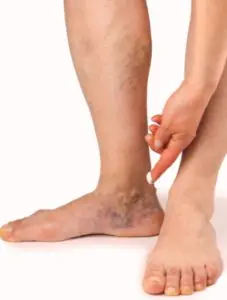In Russia, in the last decade there has been a sharp increase in mortality from varicose veins. This coincides with the global trend. According to WHO, over the past 20 years after diagnosis, 57% of patients die within 3–4 years.
Varicose veins of the lower extremities are a pathological dilatation of superficial veins, caused by disruption of the venous valves and leading to a decrease in the speed of blood flow. This leads to activation of inflammatory processes and dysfunction of all layers of the venous wall. Recently, the disease has become much younger. Women get sick almost three times more often than men.
Causes
Today the actual cause of this disease is not yet known. There is no doubt that there is a genetic predisposition. Factors that can cause varicose veins play an important role:
• age;
• overweight;
• work involving long periods of standing or sitting;
• constipation;
• pregnancy and childbirth;
• long-term wearing of high-heeled shoes;
• wearing compressive underwear;
• diabetes.
Symptoms
At the beginning of the disease, heaviness in the legs and aching pain appear. The legs get tired quickly, sometimes swell, and an unaesthetic vascular pattern appears on the skin. Sometimes these spider veins are the only manifestation of the disease. Subsequently, all symptoms become aggravated, noticeable nodules form on the veins, protruding above the surface. Local redness of the skin and, in severe cases, trophic ulcers may appear.
Diagnostics
Diagnosis of varicose veins is usually not difficult. After prescribing a standard set of tests, to clarify the diagnosis and correct choice of treatment tactics, additional studies are usually prescribed: ultrasound of the vessels of the lower extremities, rheovasography.
Treatment methods
Treatment depends on the severity of the disease. In the initial stage, it is enough to remove provoking loads, perform preventive physical exercises, wear therapeutic knitwear, take prescribed medications, and receive a massage. All this can stop the development of the disease and prevent the risk of complications. Such treatment is effective only in combination.
In more complex situations, conservative methods no longer work; in this case, minimally invasive techniques are used, and in especially severe situations, surgical operations are used.
The first is sclerotherapy. A certain substance is injected into the vein, under the influence of which it sticks together and then turns into scar cords. The same result can be achieved with microthermocoagulation - exposure to electric current and laser coagulation.
Surgery currently uses gentle techniques that make it possible to reduce incisions and remove the affected veins as accurately as possible.
These methods allow you to avoid complications of varicose veins, but do not eliminate its causes, so the problem often appears in other vessels.
Complications
Complications of varicose veins are:
- Thrombophlebitis is the formation of blood clots. The rupture of a blood clot can lead to serious consequences, it all depends on which vessel it clogs.
- Trophic ulcers – formed from varicose veins. It is impossible to completely destroy them.
- Cancerous tumors - can arise from trophic ulcers or after thrombophlebitis.
Thus, both thrombophlebitis and trophic ulcers are precancerous diseases.
When small spider veins appear on the legs, this is not just a cosmetic defect, but one of the symptoms of a serious disease. It is necessary to urgently contact a phlebologist to catch the disease at the very beginning.



